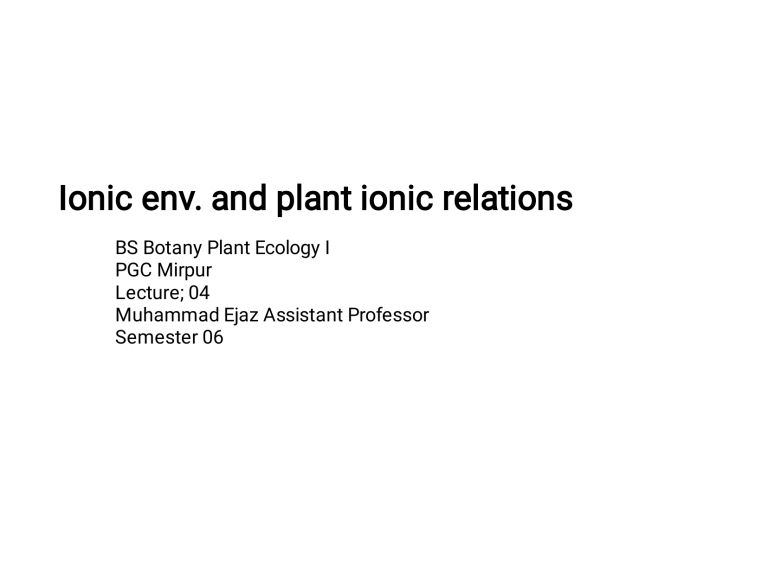
Ionic env. and plant ionic relations BS Botany Plant Ecology I PGC Mirpur Lecture; 04 Muhammad Ejaz Assistant Professor Semester 06 Homeostasis in Plants • Plant cells work best if they have the correct – Temperature – Water levels – Ion concentration • The maintenance of a constant environment in the plant body is called Homeostasis •Control of the ion concentrations across the plant cell is called ‘Ion Homeostasis’ Significance of Ion homeostasis • Uptake of nutrients is in the form of ions (NO₃⁻,NH₄⁺, PO₄³⁻,K⁺,Ca²⁺,SO₄²⁻, Zn²⁺, Fe²⁺,Mn²⁺,Cu²⁺,H₃BO₃, MoO₄²⁻, • Ion concentration maintains osmotic and pH homeostasis • Control of the ion concentrations in the cytosol is important for the regulation of metabolic enzymes • Ion concentrations are controlled by passive Electrochemic al potential-Concentration gradient -Electric-potential gradient -Hydrolytic pressure Membrane permeabilityThe extent to which a membrane permits or restricts the movement of a substance. The permeability depends on- -the chemical properties of the particular solute -the lipid composition of the membrane -the membrane proteins that facilitate the transport of specific substances. Active transportMovement of solutes against a chemical potential and requires energy input. Passive transportTransport of solutes down a chemical gradient (e.g., by diffusion) Membrane transport proteins Channel s •Transmembrane proteins formed of glycoproteins •Formed by aggregation of subunits made of proteins into cylindrical configuration forming a pore in the centre •Function as selective pores •Transport depends on electrical potential or concentration gradient •Transport specificity-The type ion crossing through the channels depends on the size of a pore, the electrochemical configuration of the protein subunits lining on the pore •Transport is always passive •Transport Ions or water •Rate of trensport-10⁸ ions per second •Gates that open and close the pore in response to external signals such as- voltage changes, hormone binding, or light. Types of Channels K⁺ Channels •The most abundant inorganic cation •Essential mineral nutrient •Osmoticum-cellular hydrostatic pressure •Enzyme activation • Stabilization of protein synthesis •Formation of membrane potential •Maintenance of cytosolic pH homeostasis •Subdivided into two channel classes: •Non-voltage-gated Or inward K⁺ channels open only at more negative potentials for inward diffusion of K⁺ •Voltage gated Or outward K⁺ channels Ca² ⁺ Channels •Calcium signal transduction is a central mechanism by which plants sense and respond to endogenous and environmental stimuli. •Cytosolic Ca²⁺ elevationCa²⁺ influx through Ca²⁺ channels in the plasma membrane •Ca²⁺ release from intracellular Ca²⁺ stores •Function in various cellular responses, including hormone responses, plant–pathogen interaction, symbiosis, salt stress, light signaling and circadian rhythm. Carrier s •Highly selective •Binding causes a conformational change in the Protein •Transport is complete when the substance dissociates from the carrier’s binding site. •Typically, carriers may transport 100 to 1000 ions or molecules per second (10⁶ times slower than transport through a channel) •Passive transport by a carrier is sometimes called facilitated diffusion Primary Active Transport • Directly Coupled to Metabolic or Light Energy • The membrane proteins that carry out primary active transport are called Ion pumps • Pumps are energy dependant channels • Electrogenic transport refers to ion transport involving the net movement of charge across the membrane. • Electroneutral transport as the name implies, involves no net movement of charge. The Plasma Membrane H⁺•Active transport of H⁺ across ATPase the plasma membrane creates gradients of pH and electric potential that drive the transport of many other substances (ions and molecules) •H⁺ -ATPases and Ca²⁺ ATPases are members of a class known as P- type ATPases, which are phosphorylated as part of the catalytic cycle that hydrolyzes ATP •H⁺ -ATPase molecules can be reversibly activated or deactivated by specific signals, such as light, hormones, The Vacuolar H ⁺ ATPase •Drives Solute accumulation into Vacuoles •More closely related to the FATPases of mitochondria and chloroplasts •They are large enzyme complexes, about 750 kDa, composed of at least ten different subunits •Vacuolar ATPases are electrogenic proton pumps that transport protons from the cytoplasm to the vacuole and generate a proton motive force across the tonoplast. •This gradient accounts for the fact that the pH of the vacuolar sap is typically about 5.5, while the cytoplasmic pH is 7.0 to 7.5. The H ⁺ Pyrophosphatase •A single polypeptide that has a molecular mass of 80 kDa. •Harnesses its energy from the hydrolysis of inorganic pyrophosphate (PPi). •The synthesis of the vacuolar H ⁺ PPase is induced by low O2 levels (hypoxia) or by chilling •The vacuolar H ⁺ -PPase might function as a backup system to maintain essential cell metabolism under conditions in which ATP supply is depleted because of the inhibition of respiration by hypoxia or chilling. •Large metabolites such as flavonoids, anthocyanins and secondary products of metabolism are sequestered in the vacuole. Ca² ⁺ ATPase Fig. Topology of plant calcium pump •Belong to the superfamily of P-type ATPases comprising also the plasma membrane H ⁺ -ATPase of fungi and plants •Ca² ⁺ signal is not restricted to the changes in the Ca² ⁺ concentration but is also presented by its spatial and temporal distribution •All these characteristics are known as “calcium signature” Secondary Active Transport • Transport solute against gradient of electrochemical potential by coupling of the uphill transport to the downhill transport • A membrane potential and a pH gradient are created at the expense of ATP hydrolysis. • The proton motive force generated by electrogenic H ⁺ transport is used in secondary active transport Symporter • the two substances are moving in the same direction Antiporter • to coupled transport in which the downhill movement of protons drives the active (uphill) transport Sucrose-H ⁺ Cotransporter Sodium-Potassium Cotransporter Sodium- Calcium Antiporter Overview of the various transport processes on the plasma membrane and tonoplast of plant cells. Techniques to Study Ion Homeostasis •Photochemical tools for studying metal ion signaling and homeostasis •Patch-clamp techniques to study cell ionic homeostasis under saline conditions •Channel cloning, mutagenesis, and expression techniques •Antibodies as tools for the study of the structure and function of channel protein •Electron microscopy High salinity Stress •Excess salt in soil or in solutions interferes with several physiological and biochemical processes •Problemsion imbalance, mineral deficiency, osmotic stress, ion toxicity and oxidative stress •The major ions involved in salt stress signalingNa ⁺, K ⁺, H ⁺ and Ca² ⁺ •It is the interplay of these ions, which brings homeostasis in the cell. http://www.knowledgebank.irri.org/ ricebreedi ngcourse/ Breeding_for_salt_tolerance.htm Salt stress on plant cells arise from the following • Disruption of ionic equilibrium: Influx of Na ⁺ dissipates the membrane potential and facilitates the uptake of Cl¯ down the chemical gradient. • Na ⁺ is toxic to cell metabolism and has deleterious effect on the functioning of some of the enzymes. • High concentrations of Na ⁺ causes osmotic imbalance, membrane disorganization, reduction in growth, inhibition of cell division and expansion. • High Na ⁺ levels also lead to reduction in photosynthesis and production of reactive oxygen species Fig. Yellowing and "burning" on tips of leaves of orange tree, sensitive to both salinity and sodium. http://www.salinitymanagement.org/Salinity% 20Management%20Guide/sp/sp_7b.html Maintenance of ion homeostasis and the possible roles of ion transporters •Ion homeostasis in saline environments is dependent on transmembrane proteins that mediate ion fluxes, including H⁺ translocating ATPases and pyrophosphatases, Ca²⁺- ATPases, secondary active transporters, and channels. •A role for ATP-binding cassette (ABC) transporters in plant salt tolerance has not been elucidated, but ABC transporters regulate cation homeostasis in yeast which is very similar to plants. Osmolytes/ Osmoprotectants Listed are common osmolytes involved in either osmotic adjustment or in the protection of structure. In all cases, protection has been shown to be associated with accumulation of these metabolites. Role of Ca2+ in relation to salt stress •Externally supplied Ca²⁺ reduces the toxic effects of NaCl, presumably by facilitating higher K⁺/Na ⁺ selectivity •SOS (salt overly sensitive) pathway results in the exclusion of excess Na+ ions out of the cell via the plasma membrane Na ⁺ /H ⁺ antiporter and helps in reinstating cellular ion • The enhanced activity of H ⁺ /ATPase proton pumping activity would furnish plasma membrane Na ⁺ /H ⁺ antiporter with a driving force to expel Na ⁺ out of the cytoplasm • The NHX-type antiporters i.e. Na ⁺ /H ⁺ located in tonoplast have been reported to increase salt-tolerance in many plant species by driving Na+ accumulation in vacuole Fig. Cellular homeostasis established after salt (NaCl) Strategies for developing salinity stress resistance plants •Conventional breeding •In vitro selection techniques -Somaclonal variation -Mutagenesis •Genetic engineering New varieties for Salt tolerance developed in following crops: Canola or rapeseed, Chickpea, Cotton, Rice, Sorghum, Soybean, Sugar cane, maize etc. Fig:Algorithm for discovering stress tolerance determinants REFERENC Books •Plant physiology(fifth edition)ES Authers-Lincoln Taiz and Eduardo Zeiger •Essential cell biology(second edition) Authers-alserts, hopkin, johnson, lewis, raff, robert and walter •Biochemistry Auther-strayer Research papers •Shilpi Mahajan, Narendra Tuteja ‘Cold, salinity and drought stresses: an overview’, Archives of biochemistry and biophysics 444 (2005) 139–158 •R. K. Sairam, Aruna Tyagi ‘Physiology and molecular biology of salinity Stress tolerance in plants’, Current Science, vol. 86, no. 3, 10 february 2004 •Paul Hasegawa, Jian-Kang Zhu ‘Plant cellular and molecular responses to high salinity’, Annu. Rev. Plant physiol. Plant mol. Biol. 2000. 51:463–99 •Fabien Jammes, Heng-Cheng hu ‘Calcium-permeable channels in plant cells’, FEBS journal 278 (2011) 4262–4276 •Ingo Dreyer, Nobuyuki Uozumi ‘Potassium channels in plant cells’, FEBS journal 278 (2011) 4293–4303 •Katarzyna Kabała, Grayna Klobus ‘Plant ca2 ⁺ -ATPases’, ACTA PHYSIOLOGIAE PLANTARUM Vol. 27. No. 4a. 2005: 559-574 •Michael G Palmgren ‘Plant plasmamembrane h ⁺ -ATPases: Powerhouses for nutrient uptake’, Annu. Rev. Plant physiol. Plant mol. Biol. 2001. 52:817–45



